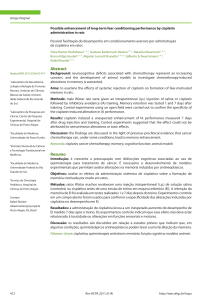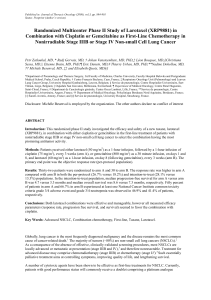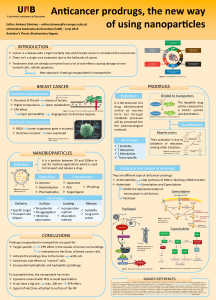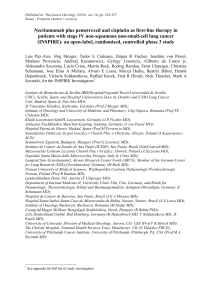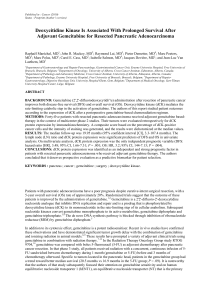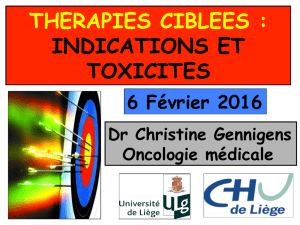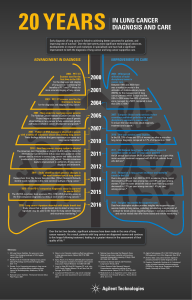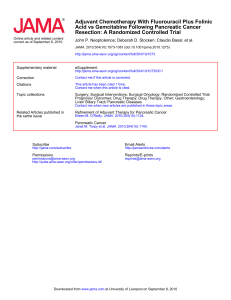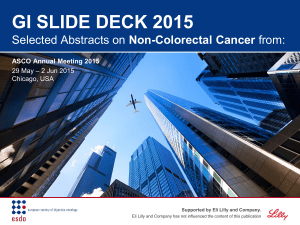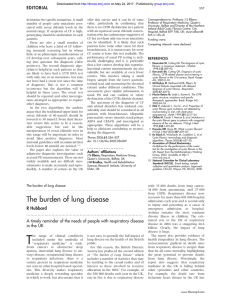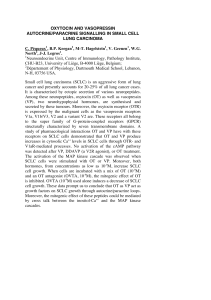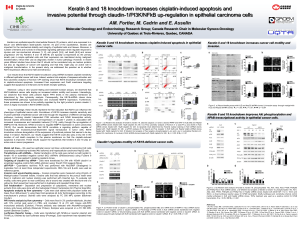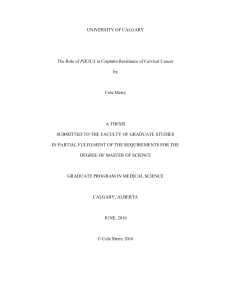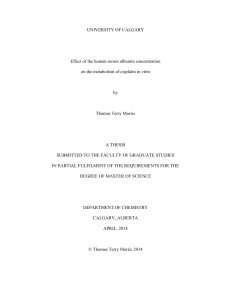Necitumumab plus gemcitabine and cisplatin versus gemcitabine
publicité
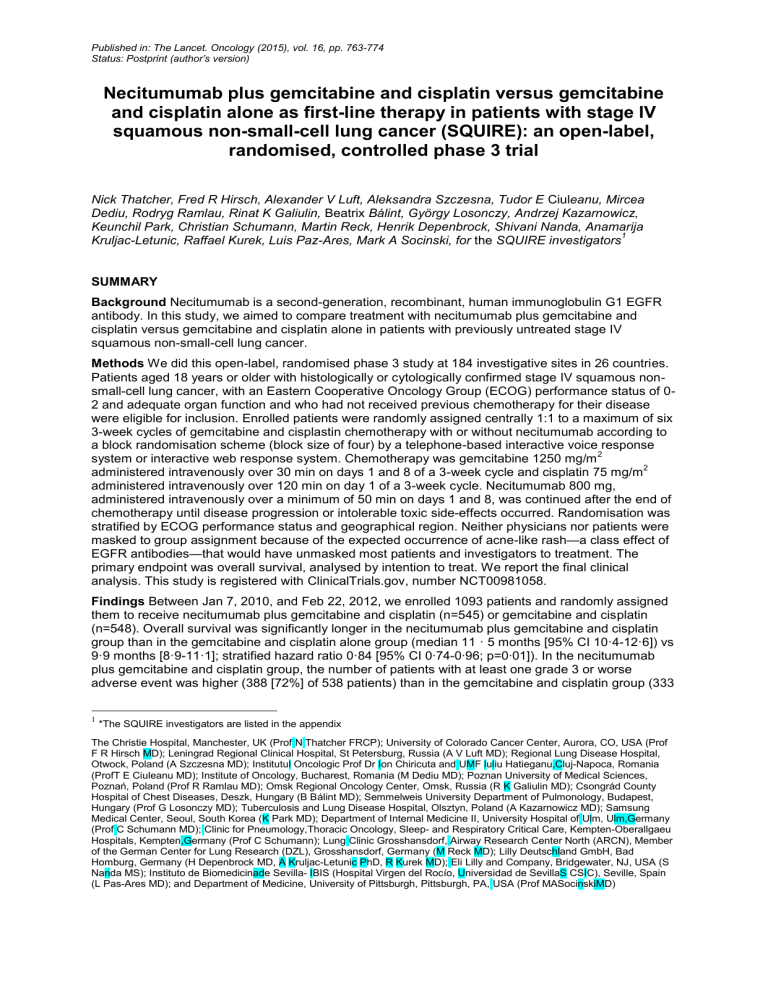
Published in: The Lancet. Oncology (2015), vol. 16, pp. 763-774 Status: Postprint (author’s version) Necitumumab plus gemcitabine and cisplatin versus gemcitabine and cisplatin alone as first-line therapy in patients with stage IV squamous non-small-cell lung cancer (SQUIRE): an open-label, randomised, controlled phase 3 trial Nick Thatcher, Fred R Hirsch, Alexander V Luft, Aleksandra Szczesna, Tudor E Ciuleanu, Mircea Dediu, Rodryg Ramlau, Rinat K Galiulin, Beatrix Bálint, György Losonczy, Andrzej Kazarnowicz, Keunchil Park, Christian Schumann, Martin Reck, Henrik Depenbrock, Shivani Nanda, Anamarija 1 Kruljac-Letunic, Raffael Kurek, Luis Paz-Ares, Mark A Socinski, for the SQUIRE investigators SUMMARY Background Necitumumab is a second-generation, recombinant, human immunoglobulin G1 EGFR antibody. In this study, we aimed to compare treatment with necitumumab plus gemcitabine and cisplatin versus gemcitabine and cisplatin alone in patients with previously untreated stage IV squamous non-small-cell lung cancer. Methods We did this open-label, randomised phase 3 study at 184 investigative sites in 26 countries. Patients aged 18 years or older with histologically or cytologically confirmed stage IV squamous nonsmall-cell lung cancer, with an Eastern Cooperative Oncology Group (ECOG) performance status of 02 and adequate organ function and who had not received previous chemotherapy for their disease were eligible for inclusion. Enrolled patients were randomly assigned centrally 1:1 to a maximum of six 3-week cycles of gemcitabine and cisplastin chemotherapy with or without necitumumab according to a block randomisation scheme (block size of four) by a telephone-based interactive voice response 2 system or interactive web response system. Chemotherapy was gemcitabine 1250 mg/m 2 administered intravenously over 30 min on days 1 and 8 of a 3-week cycle and cisplatin 75 mg/m administered intravenously over 120 min on day 1 of a 3-week cycle. Necitumumab 800 mg, administered intravenously over a minimum of 50 min on days 1 and 8, was continued after the end of chemotherapy until disease progression or intolerable toxic side-effects occurred. Randomisation was stratified by ECOG performance status and geographical region. Neither physicians nor patients were masked to group assignment because of the expected occurrence of acne-like rash—a class effect of EGFR antibodies—that would have unmasked most patients and investigators to treatment. The primary endpoint was overall survival, analysed by intention to treat. We report the final clinical analysis. This study is registered with ClinicalTrials.gov, number NCT00981058. Findings Between Jan 7, 2010, and Feb 22, 2012, we enrolled 1093 patients and randomly assigned them to receive necitumumab plus gemcitabine and cisplatin (n=545) or gemcitabine and cisplatin (n=548). Overall survival was significantly longer in the necitumumab plus gemcitabine and cisplatin group than in the gemcitabine and cisplatin alone group (median 11 · 5 months [95% CI 10·4-12·6]) vs 9·9 months [8·9-11·1]; stratified hazard ratio 0·84 [95% CI 0∙74-0∙96; p=0∙01]). In the necitumumab plus gemcitabine and cisplatin group, the number of patients with at least one grade 3 or worse adverse event was higher (388 [72%] of 538 patients) than in the gemcitabine and cisplatin group (333 1 *The SQUIRE investigators are listed in the appendix The Christie Hospital, Manchester, UK (Prof N Thatcher FRCP); University of Colorado Cancer Center, Aurora, CO, USA (Prof F R Hirsch MD); Leningrad Regional Clinical Hospital, St Petersburg, Russia (A V Luft MD); Regional Lung Disease Hospital, Otwock, Poland (A Szczesna MD); Institutul Oncologic Prof Dr Ion Chiricuta and UMF luliu Hatieganu,Cluj-Napoca, Romania (ProfT E Ciuleanu MD); Institute of Oncology, Bucharest, Romania (M Dediu MD); Poznan University of Medical Sciences, Poznań, Poland (Prof R Ramlau MD); Omsk Regional Oncology Center, Omsk, Russia (R K Galiulin MD); Csongrád County Hospital of Chest Diseases, Deszk, Hungary (B Bálint MD); Semmelweis University Department of Pulmonology, Budapest, Hungary (Prof G Losonczy MD); Tuberculosis and Lung Disease Hospital, Olsztyn, Poland (A Kazarnowicz MD); Samsung Medical Center, Seoul, South Korea (K Park MD); Department of Internal Medicine II, University Hospital of Ulm, Ulm,Germany (Prof C Schumann MD); Clinic for Pneumology,Thoracic Oncology, Sleep- and Respiratory Critical Care, Kempten-Oberallgaeu Hospitals, Kempten,Germany (Prof C Schumann); Lung Clinic Grosshansdorf, Airway Research Center North (ARCN), Member of the German Center for Lung Research (DZL), Grosshansdorf, Germany (M Reck MD); Lilly Deutschland GmbH, Bad Homburg, Germany (H Depenbrock MD, A Kruljac-Letunic PhD, R Kurek MD); Eli Lilly and Company, Bridgewater, NJ, USA (S Nanda MS); Instituto de Biomedicinade Sevilla- IBIS (Hospital Virgen del Rocío, Universidad de SevillaS CSIC), Seville, Spain (L Pas-Ares MD); and Department of Medicine, University of Pittsburgh, Pittsburgh, PA, USA (Prof MASocinskiMD) Published in: The Lancet. Oncology (2015), vol. 16, pp. 763-774 Status: Postprint (author’s version) [62%] of 541), as was the incidence of serious adverse events (257 [48%] of 538 patients vs 203 [38%] of 541). More patients in the necitumumab plus gemcitabine and cisplatin group had grade 3-4 hypomagnesaemia (47 [9%] of 538 patients in the necitumumab plus gemcitabine and cisplatin group vs six [1%] of 541 in the gemcitabine and cisplatin group) and grade 3 rash (20 [4%] vs one [<1%])∙ Including events related to disease progression, adverse events with an outcome of death were reported for 66 (12%) of 538 patients in the necitumumab plus gemcitabine and cisplatin group and 57 (11%) of 541 patients in the gemcitabine and cisplatin group; these were deemed to be related to study drugs in 15 (3%) and ten (2%) patients, respectively. Overall, we found that the safety profile of necitumumab plus gemcitabine and cisplatin was acceptable and in line with expectations. Interpretation Our findings show that the addition of necitumumab to gemcitabine and cisplatin chemotherapy improves overall survival in patients with advanced squamous non-small-cell lung cancer and represents a new first-line treatment option for this disease. Funding Eli Lilly and Company. RESEARCH IN CONTEXT Evidence before this study In the development of the study design and protocol, we did a systematic review of the published scientific literature. We searched PubMed, with no time restrictions; abstracts of major oncology congresses; and trial websites including ClinicalTrials.gov, for English-language preclinical reports and clinical trials assessing chemotherapy in patients with lung cancer, EGFR therapies in these patients, and the combination of these methods. Search terms for clinical trials of moleculartargeted therapies included "lung cancer" and "EGFR". Clinical data in support of this trial included a phase 1 pharmacological study of necitumumab in patients with advanced solid malignancies that showed necitumumab was well tolerated and had anti-tumour activity at therapeutically relevant trough concentrations. On the basis of our review of the literature and discussions with clinicians, researchers, and regulatory bodies, we postulated that combining chemotherapy with an EGFRtargeted therapy might improve treatment efficacy in patients with advanced squamous non-small-cell lung cancer. Added value of this study Ourstudy shows a significant reduction in risk of death and an overall acceptable safety profile in patients who received necitumumab plus gemcitabine and cisplatin. The improvement in overall survival in this patient population compared with those who received gemcitabine and cisplatin chemotherapy alone was supported by a corresponding significant improvement in progression-free survival and a high consistency of the effectsof the treatments in subgroup analyses. We recorded no evidence for a predictive association between an EGFR H-score of 200 or more and survival for necitumumab plus gemcitabine and cisplatin in this setting. Implications of all the available evidence The SQUIRE trial design was appropriate forthe first-line treatment of a patient population with squamous non-small-cell lung cancer and can be generalised to clinical practice. The results confirm the benefit of the addition of an EGFR antibody to standard chemotherapy in this setting and represent clinically meaningful progress in the treatment of squamous non-small-cell lung cancer. Published in: The Lancet. Oncology (2015), vol. 16, pp. 763-774 Status: Postprint (author’s version) INTRODUCTION 1 Squamous cell carcinomas account for 30% of non-small-cell lung cancers worldwide. In addition to histopathological differences, the mutational profiles of squamous and non-squamous non-small-cell 2 lung cancers are distinctive, with both of these aspects potentially affecting treatment selection. For patients with squamous non-small-cell lung cancer, although some potentially targetable molecular 1,3 lesions have been identified in tumours, including PIK3CA amplification, FGFR1 amplification, MET amplification, and DDR2 mutation, none of these biomarkers have yet been validated in this setting as predictive for particular targeted therapies, and available first-line regimens have remained essentially unchanged for the past two decades. In general, such regimens comprise a platinum-based doublet of 1,4 cisplatin or carboplatin combined with gemcitabine, vinorelbine, or a taxane. By contrast, for patients with non-squamous non-small-cell lung cancer, the availability of pemetrexed and bevacizumab as components of first-line or maintenance regimens has widened the choice of possible treatments and 5-9 provided the opportunity to improve overall survival in this patient group. Additionally, a few recurring somatic tumour mutations have been described in adenocarcinomas, offering the potential for 10-12 selective pathway-directed systemic therapy. In particular, EGFR mutations and ALK 13,14 translocations are predictive of outcome in relation to specific targeted drugs, but these mutations 1,15 are very rare in squamous non-small-cell lung cancer. Thus, although clear advances have been made in the first-line treatment of non-squamous non-small-cell lung cancer, especially adenocarcinoma, a substantial unmet need persists to improve outcomes for patients with advanced squamous non-small-cell lung cancer. We note in this context the recent US FDA approval of additional second-line options for patients progressing on or after platinum-based chemotherapy: the 16 PD-1 antibody nivolumab for metastatic squamous non-small-cell lung cancer; and the human immunoglobulin G1 VEGFR-2 antibody ramucirumab, in combination with docetaxel, for treatment of 17 metastatic non-small-cell lung cancer (including that of squamous histology). However, only about 18 half of patients continue to second-line treatment, and neither drug is indicated in the first-line setting. Most non-small-cell lung cancer tumours express EGFR protein, the high-level expression of which is 19,20 20 more common in squamous than in non-squamous disease. In the phase 3 FLEX trial, the addition of the chimeric EGFR antibody cetuximab to cisplatin and vinorelbine improved overall survival in the first-line treatment of EGFR-expressing, advanced non-small-cell lung cancer, unselected (adenocarcinoma, squamous cell carcinoma, and other) by histological subtype (hazard ratio [HR] 0∙871 [95% CI 0∙762-0∙9%]; p=0∙044). However, the survival benefit was greatest in the subgroup of patients with squamous non-small-cell lung cancer (HR 0∙80 [95% CI 0∙64-1∙00]), but was accompanied by a higher frequency of febrile neutropenia overall. Necitumumab is a second-generation, recombinant, human immunoglobulin G1 EGFR monoclonal antibody that binds to EGFR with high affinity, competing with natural ligands and thereby preventing receptor activation and downstream signalling. In murine non-small-cell lung cancer xenograft models, the addition of necitumumab to gemcitabine and cisplatin—an established chemotherapy regimen for 21,22 the first-line treatment of advanced squamous non-small-cell lung cancer —resulted in a substantial 23 increase in anti-tumour activity. Our randomised, phase 3 study (SQUamous NSCLC treatment with the Inhibitor of EGF REceptor [SQUIRE]) assessed the efficacy and safety of necitumumab plus gemcitabine and cisplatin as first-line treatment for patients with advanced squamous non-small-cell 24 lung cancer. In parallel, the phase 3 INSPIRE study assessed the efficacy and safety of necitumumab plus pemetrexed and cisplatin as first-line treatment for patients with advanced nonsquamous non-small-cell lung cancer. METHODS Study design and participants We did this open-label, multicentre, randomised, phase 3 study at 184 investigative sites in 26 countries (listed in the appendix). The full inclusion and exclusion criteria are provided in the appendix. Briefly, patients aged 18 years or older with histologically or cytologically confirmed stage IV 25 (according to the AJCC Cancer Staging Manual, seventh edition ) squamous non-small-cell lung cancer were eligible for enrolment. Other key inclusion criteria were an Eastern Cooperative Oncology Group (ECOG) performance status of 0-2 and adequate organ function (white blood cell count ≥3000 cells per µL, with an absolute neutrophil count ≥1500 cells per µL, platelets ≥100000 per µL, and haemoglobin ≥9∙5 g/dL; total bilirubin ≤1∙5x the upper limit of normal [ULN], and aspartate aminotransferase and alanine aminotransferase concentrations ≤5∙0xULN in the presence of liver metastases or ≤2∙5xULN in the absence of liver metastases and serum creatinine ≤1∙2x ULN or a Published in: The Lancet. Oncology (2015), vol. 16, pp. 763-774 Status: Postprint (author’s version) calculated creatinine clearance >50 mL per min). The availability of archived tumour tissue for the analysis of biomarkers was also an inclusion criterion. Key exclusion criteria were: previous chemotherapy for advanced non-small-cell lung cancer, major surgery in the 4 weeks before randomisation, chest irradiation within the 12 weeks before randomisation, the presence of brain metastases that were symptomatic or needed ongoing treatment with steroids or anticonvulsants, clinically relevant coronary artery disease or uncontrolled congestive heart failure, and National Cancer Institute-Common Terminology Criteria for Adverse Events (NCI-CTCAE) version 3.0 grade 2 or worse peripheral neuropathy. The study was done in compliance with the Declaration of Helsinki, International Conference on Harmonisation Guidelines for Good Clinical Practice, and applicable local regulations. The protocol was approved by the ethics committees of all participating centres and all patients provided written informed consent before study entry. Randomisation and masking Patients were randomly assigned (1:1) with a stratified, block randomisation scheme (block size of four) via a telephone-based interactive voice response system or interactive web response system to receive necitumumab plus gemcitabine and cisplatin or gemcitabine and cisplatin alone. Randomisation was done centrally by Pharmaceutical Product Development, LLC (Morrisville, NC, USA), and was stratified by ECOG performance status (0-1 vs 2) and geographical region (North America, Europe, Australia vs South America, South Africa, India vs eastern Asia). The first dose of study drug was planned to be administered within 7 days of randomisation. Neither physicians nor patients were masked to group assignment because the expected occurrence of acne-like rash—a known class effect of EGFR antibodies—would have unmasked most patients and investigators to treatment. An independent data monitoring committee assessed safety during the study on a regular basis; this committee was an independent multidisciplinary group consisting of five members (three medical oncologists, a drug safety expert, and a biostatistician) with no financial s or other interest in the study. Procedures 2 Chemotherapy comprised a maximum of six 3-week cycles of gemcitabine 1250 mg/m administered 2 intravenously over 30 min on days 1 and 8, and cisplatin 75 mg/m administered intravenously over 120 min on day 1. For those assigned to receive it, necitumumab at an absolute dose of 800 mg was given intravenously on days 1 and 8, over a minimum of 50 min and before gemcitabine administration. Antiemetic premedication for gemcitabine and cisplatin was administered according to local practice. Pre-emptive treatment for skin toxicity was allowed only after the first cycle. After the end of chemotherapy, patients who were free of disease progression continued to receive single-agent necitumumab on the same treatment schedule until radiographic documentation of disease progression, the occurrence of toxic effects necessitating cessation, or withdrawal of consent. Dose modifications of chemotherapy or necitumumab were allowed according to protocol-defined criteria (appendix). 26 We assessed tumour response radiographically according to RECIST version 1∙0 criteria at baseline, within 21 days before randomisation, and then every 6 weeks after the first dose of study therapy until radiographic documentation of progressive disease. The appendix provides details of the timing of laboratory and other assessments. Adverse events were coded according to the Medical Dictionary for Regulatory Activities, version 16∙0 and graded with the NCI-CTCAE version 3.0. We assessed patient 27 28 health status with the Lung Cancer Symptom Scale and the EuroQol-5D. Tumour EGFR protein expression was assessed at a Clinical Laboratory Improvement Amendments (CLIA)-certified laboratory by immunohistochemistry with the EGFR PharmDx Kit (Dako, Glostrup, Denmark) and assessed independently by two pathologists. The level of EGFR expression was classified by 29,30 immunohistochemistry score (H-score) on a scale of 0-300, as described previously Outcomes The primary endpoint was overall survival, defined as the time from randomisation to death from any cause. Secondary endpoints were progression-free survival, defined as the time from randomisation until the first radiographic documentation of objective progression or death from any cause; objective response, defined as the proportion of patients with a best response of complete or partial response; time to treatment failure, defined as time from the date of randomisation until the date of the first radiographic documentation of progressive disease, death by any cause, discontinuation of treatment for any Published in: The Lancet. Oncology (2015), vol. 16, pp. 763-774 Status: Postprint (author’s version) reason, or initiation of new anticancer therapy; health status; immunogenicity of necitumumab; safety of necitumumab; and pharmacokinetics of necitumumab. Figurel:Trial profile *Primary reasons are listed, †Patients who completed all planned cycles of chemotherapy. ‡Radiologically documented. Statistical analysis We used a two-tailed log-rank test at the 0∙05 significance level and calculated that enrolment of 1080 patients (with a 5% dropout rate considered) would give 90% power to detect a statistically significant difference of overall survival with an HR for necitumumab plus gemcitabine and cisplatin versus gemcitabine and cisplatin alone of 0∙8, and a calculated improvement in median overall survival from 11∙0 months for gemcitabine and cisplatin to 13·75 months for necitumumab plus gemcitabine and 31 cisplatin. We planned to do the final analysis when 844 deaths had occurred. We assessed efficacy in the intention-to-treat population that included all randomly assigned patients. Safety was assessed in all patients who received at least one dose of study medication and was analysed according to actual treatment received. For the primary and secondary analyses, we 32 estimated overall and progression-free survival using the Kaplan-Meier method and we compared these outcomes between treatment groups using the log-rank test, stratified by the randomisation strata. Overall survival was censored on the last date that the patient was known to be alive. We estimated HRs and 95% CIs for necitumumab plus gemcitabine and cisplatin versus gemcitabine and cisplatin from stratified Cox proportional hazards models. To formally test the proportional hazards assumption, a Cox proportional hazards model was fitted (using the PHREG procedure in SAS) for overall survival with the following predictors: treatment, and an interaction term of treatment and log of event time. We compared the proportion of patients with an objective response in each treatment group using the Cochran-Mantel-Haenszel test, adjusting for the stratification variables. In the event that a statistically 33 significant result was recorded for the primary endpoint, we planned to use Hochberg's method to adjust for multiplicity of testing in relation to progression-free survival and objective response; if the least significant p value from these endpoints was smaller than 0∙05, both null hypotheses could be Published in: The Lancet. Oncology (2015), vol. 16, pp. 763-774 Status: Postprint (author’s version) rejected to claim significance for both. Otherwise, if the most significant p value was smaller than 0∙025, the null hypothesis was to be rejected for this endpoint and the result judged to be statistically significant. In a preplanned exploratory analysis, we categorised patients into high (H-score ≥200) and low (H29 score <200) tumour EGFR expression groups, as previously reported, to investigate whether or not an H-score of 200 or higher was predictive for necitumumab benefit. HR calculations for EGFR expression subgroups were unstratified, and we calculated p values using likelihood ratio tests. We also assessed interactions between treatment groups and EGFR expression subgroups in relation to these endpoints using likelihood ratio tests. SAS version 9.1.3 was used for data analyses. This study is registered with ClinicalTrials.gov, number NCT00981058. Role of the funding source The funder of the study was responsible for data management, commissioning of laboratory investigations, and statistical analysis, and designed the study in conjunction with NT, FRH, LP-A, and MAS (the steering committee investigators). The funder interpreted data in collaboration with the authors and supported development of the report by providing medical writing and editorial assistance. The steering committee had full access to all the data in the study and had the final responsibility for the decision to submit for publication. Table 1: Baseline characteristics Age (years) Age group (years) <65 ≥65 to <70 ≥70 Sex Male Female ECOG performance status* 0 1 2 Ethnic origin White Asian Black or African-American All others Smoking history Smoker Non-smoker Ex-light smoker Missing Geographical region† North America, Europe, or Australia South America, South Africa, or, India Eastern Asia Disease histology Squamous Other‡ Necitumumab plus Gemcitabine and gemcitabine and cisplatin cisplatin (n=548) (n=545) 62 (32-84) 62 (32-86) 332 (61%) 105 (19%) 108 (20%) 340 (62%) 111 (20%) 97 (18%) 450 (83%) 95 (17%) 458 (84%) 90 (16%) 164 (30%) 332 (61%) 49 (9%) 180 (33%) 320 (58%) 47 (9%) 457 (84%) 43 (8%) 5 (<1%) 40 (7%) 456 (83%) 42 (8%) 6 (1%) 44 (8%) 500 (92%) 26 (5%) 18 (3%) 1 (<1%) 495 (90%) 27 (5%) 26 (5%) 0 472 (87%) 475 (87%) 30 (6%) 32 (6%) 43 (8%) 41 (7%) 543 (100%) 2 (<1%) 545 (99%) 3 (<1%) Published in: The Lancet. Oncology (2015), vol. 16, pp. 763-774 Status: Postprint (author’s version) Necitumumab plus Gemcitabine and gemcitabine and cisplatin cisplatin (n=548) (n=545) (Continued from previous page) Number of metastatic organ systems 0 1 2 >2 Sites of metastatic disease Bone Brain Liver Lung Lymph nodes Peritoneal Pleural Skin Soft tissue Other Disease stage at study entry§ IV¶ IIIBwithout malignant pleural effusion|| Missing Previous anticancer therapy Surgery Radiotherapy Systemic (adjuvant/neoadjuvant) 0 51 (9%) 193 (35%) 301 (55%) 1 (<1%) 50 (9%) 193 (35%) 304 (55%) 120 (22%) 28 (5%) 109 (20%) 453 (83%) 431 (79%) 20 (4%) 149 (27%) 9(2%) 23 (4%) 156 (29%) 131 (24%) 30 (5%) 117 (21%) 453 (83%) 451 (82%) 17 (3%) 155 (28%) 8 (1%) 21 (4%) 146 (27%) 543 (100%) 1 (<1%) 546 (100%) 1 (<1%) 1 (<1%) 1 (<1%) 117 (21%) 42 (8%) 23 (4%) 106 (19%) 46 (8%) 17(3%) Data are median (IQR) or n (%). ECOG=Eastern Cooperative Oncology Group. *One patient with ECOG performance status 3 was accidentally enrolled and randomly assigned to the gemcitabine and cisplatin group; this patient did not receive treatment, † As recorded on the electronic case report form. ‡Squamous cell histology not confirmed. §According to the American Joint Committee on Cancer (AJCC) Staging Manual edition effective at the time of randomisation. ¶Includes patients with stage IIIB disease with malignant pleural effusion, defined as stage IV in the AJCC Cancer Staging Manual, seventh edition. ||These patients with stage IIIB disease without malignant pleural effusion were enrolled accidentally. RESULTS Between Jan 7, 2010, and Feb 22, 2012, we enrolled 1093 eligible patients and randomly assigned them to necitumumab plus gemcitabine and cisplatin (n=545) or gemcitabine and cisplatin (n=548). Seven patients in each group did not receive study treatment, and therefore the safety population comprised 1079 patients (figure 1). The baseline characteristics of the treatment groups were well balanced (table 1); notably, 605 (55%) of 1093 patients had metastases to more than two organ systems and 96 (9%) had an ECOG performance status of 2. Data cutoff for the present analysis was June 17, 2013, at which time 860 (79%) of 1093 patients had died (censoring rate: 233 [21%] of 1093 patients). The median duration of follow-up was 25·2 months (IQR 19∙7-30∙5) in the necitumumab plus gemcitabine and cisplatin group and 24∙8 months (19∙4-31∙3) in the gemcitabine and cisplatin group. Exposure to chemotherapy was similar in both treatment groups (appendix). The median number of cycles of both gemcitabine and cisplatin was six (IQR 3-6) in the necitumumab plus gemcitabine and cisplatin group, and five (3-6) in the gemcitabine and cisplatin group. The proportion of patients completing at least six cycles of therapy with gemcitabine was 294 (55%) of 538 in the necitumumab plus gemcitabine and cisplatin group versus 259 (48%) of 541 in the gemcitabine and cisplatin group, and for cisplatin was 286 (53%) of 538 versus 249 (46%) of 541; the median relative dose intensities for gemcitabine were 86% (IQR 75-97) versus 86% (74-96) and for cisplatin were 95% (86-99) versus 95% (86-100), respectively. Patients who continued with necitumumab after the end of chemotherapy (n=275) received a median of four additional cycles of treatment (IQR 2-8). Of the 528 patients who received necitumumab plus gemcitabine and cisplatin and whose serum was analysed for the presence of anti-necitumumab antibodies, 81 (15%) had positive samples at any time during the study Published in: The Lancet. Oncology (2015), vol. 16, pp. 763-774 Status: Postprint (author’s version) and 15 (3%) had positive samples after treatment. The overall frequency of treatment-emergent antibody positive samples was judged to be too low to allow any further analysis. Necitumumab had the expected pharmacokinetic characteristics of an immunoglobulin G-type monoclonal antibody. Accumulation of necitumumab drug concentration across cycles was consistent 34 with the previously reported half-life of necitumumab from other studies (data not shown). Table 2 summarises the efficacy results. Overall survival was statistically significantly better in the necitumumab plus gemcitabine and cisplatin group than in the gemcitabine and cisplatin group (stratified HR 0·84 [95% CI 0·74-0·96], p=0∙01). The Kaplan-Meier curves show an early separation in favour of the necitumumab plus gemcitabine and cisplatin group from around 3 months that is maintained for the duration of the study (figure 2A). The Cox proportional hazards model test indicated that no violation of the proportional hazards assumption had occurred. In the necitumumab plus gemcitabine and cisplatin group, progression-free survival was also statistically significantly improved compared with the gemcitabine and cisplatin group (table 2, figure 2B) and time to treatment failure was also longer than in the gemcitabine and cisplatin group (stratified HR 0·84 [0·75-0·95], p=0·006; table 2). In subgroup analyses of overall and progression-free survival, the necitumumab treatment benefit was reported across most subgroups (figure 3A, 3B). Objective responses were recorded in similar proportions of patients in the two groups Cochran-MantelHaenszel p=0∙40; table 2). However, disease control was statistically significantly more common in the necitumumab plus gemcitabine and cisplatin group than in the gemcitabine and cisplatin group (Cochran-Mantel-Haenszel p=0·043; table 2). The numbers of patients who received post-study systemic anticancer therapy were similar in the two groups: 258 (47%) of 545 in the necitumumab plus gemcitabine and cisplatin group and 245 (45%) of 548 in the gemcitabine and cisplatin group (appendix). Tissue samples from 982 (90%) of 1093 patients were evaluable by immunohistochemistry for EGFR protein expression level. EGFR expression was high (H-score ≥200) in 374 (38%) of 982 cases and low (H-score <200) in 608 (62%). We noted that the HR for overall survival for necitumumab plus gemcitabine and cisplatin versus gemcitabine and cisplatin alone was more favourable in patients bearing tumours with high EGFR expression (HR 0·75 [95% CI 0·60-0·94]) than in those with low EGFR expression (0·90 [0·75-1·07]; figure 4). There seemed to be no difference between high and low H-score groups when assessing progression-free survival (figure 4). For both overall and progression-free survival, interaction tests did not show a significant difference in HRs between the high versus low EGFR expression group, consistent with a discriminatory H-score threshold of 200 not being predictive of a differential necitumumab effect (figure 4, appendix). Assessment of main-effects models using this threshold also did not show significant prognostic associations with overall survival (p=0∙67) or progression-free survival (p=0∙95; data not shown). 388 (72%) of 538 patients in the necitumumab plus gemcitabine and cisplatin group and 333 (62%) of 541 in the gemcitabine and cisplatin group had one or more grade 3 or worse treatment-emergent adverse events (appendix). Grade 3 or worse adverse events that were more common in the necitumumab plus gemcitabine and cisplatin group than in the gemcitabine and cisplatin group included hypomagnesaemia (47 [9%] of 538 vs six [1%] of 541 patients) and rash (20 [4%] vs one [<1%] patient, respectively; appendix). The incidence of grade 3 or worse diarrhoea was similar between treatment groups (nine [2%] of 538 vs eight [1%] of 541 patients, respectively). We recorded adverse events leading to delay or modification of at least one study drug in 321 (60%) of 538 patients in the necitumumab plus gemcitabine and cisplatin group and 312 (58%) of 541 in the gemcitabine and cisplatin group. The most frequent of these events in both groups were blood and lymphatic system disorders (neutropenia, thrombocytopenia, anaemia, and leukopenia), which occurred in 214 (40%) of 538 patients in the necitumumab plus gemcitabine and cisplatin group and 227 (42%) of 541 in the gemcitabine and cisplatin group. Adverse events leading to discontinuation of at least one study drug were reported by 168 (31%) of 538 patients in the necitumumab plus gemcitabine and cisplatin group and by 133 (25%) of 541 in the gemcitabine and cisplatin group. Neutropenia and thrombocytopenia were the most common reasons for treatment discontinuation of any therapy (data not shown). Including events related to disease progression, adverse events with an outcome of death were reported for 66 (12%) of 538 patients in the necitumumab plus gemcitabine and cisplatin group and 57 (11%) of 541 patients in the gemcitabine and cisplatin group (appendix); these were deemed to be related to study drugs in 15 (3%) and ten (2%) patients, respectively. Serious adverse events were reported more frequently in patients in the necitumumab plus gemcitabine and cisplatin group (257 [48%] of 538 patients) than in the gemcitabine and cisplatin Published in: The Lancet. Oncology (2015), vol. 16, pp. 763-774 Status: Postprint (author’s version) group (203 [38%] of 541). To further assess safety, adverse events of interest were defined on the basis of the known safety profiles of other EGFR antibodies and previous clinical experience with necitumumab, gemcitabine, or cisplatin (table 3). Events pooled under the categories of skin reactions, rash, hypomagnesaemia, and venous thromboembolic events were reported more frequently (any grade and grade 3 or worse) in the necitumumab plus gemcitabine and cisplatin group than in the gemcitabine and cisplatin group. For example, the incidence of venous thromboembolic events of any grade was 49 (9%) of 538 patients in the necitumumab plus gemcitabine and cisplatin group versus 29 (5%) of 541 patients in the gemcitabine and cisplatin group, whereas the incidence of grade 3 or worse of these events was 27 (5%) versus 14 (3%), respectively. Notably, the rate of fatal venous or arterial thromboembolic events did not differ significantly between treatment groups (<1% in both groups). Overall, the safety profile was generally similar for subgroups of patients aged younger than 70 years and those aged 70 years or older (appendix). Analyses of health status did not suggest a consistent or compelling difference between the treatment groups. In particular, time to deterioration for the six major symptoms associated with lung malignancies, as measured on the Lung Cancer Symptom Scale, was generally similar between treatment groups, which indicates that the addition of necitumumab to gemcitabine and cisplatin was 35 not associated with deterioration in patient health-related quality of life (appendix). Table2: Efficacy endpoints Overall survival Deaths Median overall survival, months (95% CI) 1 year overall survival (95% CI) 2 year overall survival (95% CI) Progression-free survival Deaths or disease progressions Median progression-free survival, months (95% CI) 3 month progression-free survival (95% CI) 6 month progression-free survival (95% CI) Time to treatment failure Events Mediantime,months(95%CI) Response Best overall response Complete response Partial response Stable disease Progressive disease Not evaluable Not assessed Patients achieving an objective response (%; 95% CI) Patients achieving disease control (%;95%CI)* Necitumumab plus gemcitabine and cisplatin (n=545) Gemcitabine and cisplatin (n=548) 418 (77%) 11·5 (10·4-12·6) 48% (43-52) 20% (16-24) 442 (81%) 9·9 (8·9-11·1) 43% (39-47) 17% (13-20) 431 (79%) 5·7 (5·6-6·0) 417 (76%) 5·5(4·8-5·6) 79% (76-83) 45% (40-49) 73% (68-76) 37% (33-42) 529 (97%) 4·3 (4·2-4·8) 528 (96%) 3·6 (3·3-4·1) 0 170 (31%) 276 (51%) 41 (8%) 4 (<1%) 54 (10%) 170 (31%; 27-35) 3 (<1%) 155 (28%) 264 (48%) 55 (10%) 12 (2%) 59 (11%) 158 (29%; 25-33) 446 (82%; 78-85) 422 (77%; 73-80) Data are n (%) unless otherwise indicated. *Defined as the proportion of patients who had a best response of complete response, partial response, or stable disease (prespecified analysis). Published in: The Lancet. Oncology (2015), vol. 16, pp. 763-774 Status: Postprint (author’s version) Figure 2: Kaplan-Meier estimates of overall and progression-free survival (A) Overall survival and (B) progression-free survival in the intention-to-treat population.The stepped appearance of the Kaplan-Meier plot is a function of the strict assessment of response status every 6 weeks. HR=hazard ratio. Published in: The Lancet. Oncology (2015), vol. 16, pp. 763-774 Status: Postprint (author’s version) Figure3: Subgroup analyses (A) Overall survival and (B) progression-free survival in subgroups defined by baseline characteristics. HR=hazard ratio. ECOG=Eastern Cooperative Oncology Group. *Stratified HR for intention-to-treat population; unstratified HR for subgroups. Published in: The Lancet. Oncology (2015), vol. 16, pp. 763-774 Status: Postprint (author’s version) Figure4 : Forest plots of overall (A) and progression-free (B) survival in high (H-score ≥200) and low (H-score <200) tumour EGFR expression groups HR=hazard ratio. *Stratified HRfor iπteπtioπ-to-treat population; unstratified HRfor H-scores ≥200 and <200. Table 3: Adverse events of interest Necitumumab plus gemcitabine and Gemcitabine and cisplatin (n=541) cisplatin (n=538) Grade 1-2 Grade 3 Grade 4 Grade 5 Grade 1-2 Grade 3 Grade 4 Grade 5 Neutropenia 104 (19%) 97 (18%) 34(6%) 0 99 (18%) 106 43 (8%) 0 (20%) Febrile neutropenia 2 (<1%) 3 (<1%) 1 (<1%) 0 1 (<1%) 6 (1%) 1 (<1%) 0 Anaemia 168 (31%) 55 (10%) 2 (<1%) 0 189 (35%) 56 (10%) 3 (<1%) 0 Thrombocytopenia 62 (12%) 38 (7%) 17 (3%) 0 88 (16%) 35(6%) 23 (4%) 0 Diarrhoea 75 (14%) 9 (2%) 0 0 53 (10%) 6 (1%) 2 (<1%) 0 Fatigue 190 (35%) 38 (7%) 1 (<1%) 0 192 (35%) 36 (7%) 2 (<1%) 0 Hypomagnesaemia 118 (22%) 37 (7%) 13 (2%) 0 79 (15%) 6 (1%) 0 0 Skin reactions 380 (71%) 44 (8%) 0 0 61 (11%) 3 (<1%) 0 0 Rash 372 (69%) 38 (7%) 0 0 53 (10%) 2 (<1%) 0 0 Hypersensitivity/infusion- 6 (1%) 2 (<1%) 0 0 11 (2%) 0 0 0 related reaction Conjunctivitis 38 (7%) 2 (<1%) 0 0 12 (2%) 0 0 0 Interstitial lung disease 3 (<1%) 1 (<1%) 0 1 (<1%) 1 (<1%) 3 (<1%) 0 0 (pneumonitis) Arterial thromboembolic 8 (1%) 13 (2%) 5 (<1%) 3 (<1%) 10 (2%) 8(1%) 2 (<1%) 1 (<1%) events Venous thromboembolic 22 (4%) 19 (4%) 7 (1%) 1 (<1%) 15 (3%) 5 (<1%) 8 (1%) 1 (<1%) events Data are n (%). The table shows adverse events of interest possibly related to study treatment, according to either composite categories or preferred terms (febrile neutropenia and diarrhoea only). Adverse events of grade 1-2 in 10% or more of patients in either treatment group, or grades 3-5 in one or more patients in either treatment group, are presented in the appendix. DISCUSSION Our findings show that the addition of necitumumab to gemcitabine and cisplatin was associated with a statistically significant improvement in overall survival in patients with advanced squamous nonsmall-cell lung cancer. This treatment effect was supported by a corresponding statistically significant improvement in progression-free survival. In this broad patient population, which is typical of one seen in clinical practice, outcome improvements were recorded across major subgroups at a similar level of magnitude. Notably, a necitumumab benefit was apparent for patients with an ECOG performance status of 2. Although the subgroup analyses provided no evidence that patients aged 70 years or older benefited from the addition of necitumumab to gemcitabine and cisplatin, we cannot exclude the possibility that this is a chance finding. The safety profile of necitumumab combined with gemcitabine 36 and cisplatin was acceptable and consistent across patient subgroups, including in elderly patients. Published in: The Lancet. Oncology (2015), vol. 16, pp. 763-774 Status: Postprint (author’s version) These findings are consistent with results from previous clinical trials and a meta-analysis of individual patient data from four randomised studies in which chemotherapy plus the chimeric EGFR antibody 37 cetuximab, which interacts with a similar EGFR epitope to necitumumab, was compared with 38 chemotherapy alone in patients with non-small-cell lung cancer. The meta-analysis showed a clear overall survival benefit for cetuximab in patients with squamous non-small-cell lung cancer (HR 0·77 24 [95% CI 0·64-0·93]). By contrast, in the parallel phase 3 INSPIRE trial, the addition of necitumumab to a first-line pemetrexed and cisplatin treatment regimen did not improve overall survival in patients with non-squamous non-small-cell lung cancer. The early divergence of the Kaplan-Meier plots for overall survival (at around 3 months) and progression-free survival (at around 2 months) in our study suggests a clear benefit of necitumumab, which starts during the chemotherapy phase of treatment. However, the study design does not allow us to ascertain the benefit of the continued administration of necitumumab after the end of chemotherapy. Since roughly equal numbers of patients in the treatment groups received post-study systemic anticancer therapy and in view of the fact that the type of post-study systemic anticancer therapy also seemed to be reasonably balanced between the treatment groups, our data suggest that the overall survival benefit in the necitumumab plus gemcitabine and cisplatin group is based on the addition of necitumumab to chemotherapy, rather than an imbalance in post-study systemic anticancer therapy. The addition of necitumumab to gemcitabine and cisplatin was associated with an increased occurrence of grade 3 or worse adverse events. This finding was especially apparent in relation to hypomagnesaemia and skin reactions, which are manageable side-effects typically associated with 39,40 EGFR antibodies. Also in line with expectations for such agents when combined with platinum41 based chemotherapy venous thromboembolic events were more common in the necitumumab plus gemcitabine and cisplatin group than in the control group. However, importantly, the incidence of fatal thromboembolic events did not differ between treatment groups. Moreover, no relevant increase in the incidence of toxicities typically associated with chemotherapy occurred in the necitumumab plus 20 gemcitabine and cisplatin group. By contrast with data from the FLEX trial, febrile neutropenia was reported rarely and the incidence was essentially balanced between treatment groups, as was that of 42,43 grade 3 or worse neutropenia. In line with expectations for a human antibody no increases in the overall incidence of hypersensitivity or infusion-related reactions associated with the administration of necitumumab were reported. High-level expression of EGFR protein in advanced non-small-cell lung cancer (tumour H-score ≥200) might be predictive for the overall survival benefit associated with the addition of cetuximab to first-line 29 chemotherapy In a prospectively planned analysis, we therefore explored whether or not an H-score of 200 or higher was of predictive value in patients receiving necitumumab plus gemcitabine and cisplatin. We noted that interaction test p values for treatment by EGFR expression level for both overall and progression-free survival were not significant. These findings are consistent with a discriminatory H-score of 200 not being of predictive value. Notably, a discriminatory EGFR H-score of 200 was also not predictive for treatment efficacy in patients with non-squamous non-small-cell lung 24 cancer who received necitumumab plus pemetrexed and cisplatin. Exploratory analyses in this study for potential associations between efficacy and another potential EGFR pathway or non-small-cell lung cancer biomarker, or the early occurrence of skin rash are ongoing and will be reported elsewhere. In conclusion, to the best of our knowledge, SQUIRE is the first trial of first-line treatment for advanced squamous non-small-cell lung cancer to show that the addition of a targeted agent to a platinum-based doublet improves survival. These efficacy data and the acceptable safety profile of necitumumab suggest a favourable benefit-to-risk ratio for this combination treatment. Contributors NT was a member of the study steering committee and contributed to data analysis and interpretation, and drafting, review, and approval of the report. FRH was a member of the study steering committee and contributed to planning, study design, data interpretation, and drafting, review, and approval of the report. TEC contributed to data and interpretation; drafting, review, and approval of the submitted report; and the decision to submit for publication. AS, RR, RKG, GL, AK, KP, and MR contributed to drafting, review, and approval of the report. AVL, MD, BB, and CS contributed to patient recruitment, data collection, and drafting, review, and approval of the report. HD and SN contributed to data Published in: The Lancet. Oncology (2015), vol. 16, pp. 763-774 Status: Postprint (author’s version) analysis and interpretation, and drafting, review, and approval of the report. AK-L contributed to patient recruitment, data collection, and final approval of the report. RK was a member of the steering committee for the study and contributed to study design, data analysis, data interpretation, and drafting, review, and approval of the submitted report. LP-A was a member of the steering committee for the study and contributed to study design; patient recruitment; data collection, analysis, and interpretation; and drafting, review, and approval of the report. MAS was a member of the steering committee for the study and contributed to drafting, review, and approval of the report. Declaration of interests NT has received personal fees from Lilly during the conduct of the study and personal fees from Multiple, outside the submitted work. FRH's laboratory has received a grant from Lilly-ImClone for doing biomarker studies related to this clinical trial, and he has participated in advisory boards for Eli Lilly and Company. FRH has also received grants from the University of Colorado during the conduct of the study, and from Lilly-ImClone for consultancy and service on advisory boards outside the submitted work. TEC has received personal fees from Eli Lilly and Company, Merck, Bristol-Myers Squibb, Amgen, Roche, Pfizer, Novartis, Sandoz, Bayer, Vifor Pharma, Janssen, and Merck Sharp and Dohme, outside the submitted work. MD has received personal fees from Eli Lilly and Company, Hoffmann La-Roche, Boehringer Ingelheim, Pfizer, Amgen, Novartis, GlaxoSmithKline, and AstraZeneca, outside the submitted work. RR has received personal fees from Eli Lilly and Company, Boehringer Ingelheim, Merck Sharp and Dohme, and Roche, outside the submitted work. KP has received personal fees from Eli Lilly and Company, outside the submitted work. CS has received grants from Eli Lilly and Company during the conduct of the study, and a speaker's fee from Eli Lilly and Company, outside the submitted work. MR has received personal fees from Hoffmann-La Roche, Eli Lilly and Company, Merck Sharp and Dohme, BMS, AstraZeneca, Pfizer, Boehringer Ingelheim, and Novartis, outside the submitted work. HD, SN, AK-L, and RK are employees of Eli Lilly and Company. LP-A has received honoraria from Eli Lilly and Company. AVL, AS, RKG, BB, GL, AK, and MAS declare no competing interests. Acknowledgments This study was funded by Eli Lilly and Company. We thank the patients, their families and the study personnel across all sites for participating in this study. LP-A is funded by Fondo de Investigación Sanitaria (PI1102688) and Red Temática de Investigación Cooperativa en Cáncer (R12/0036/0028). Writing and editorial assistance were funded by Eli Lilly and Company: Jim Heighway of Cancer Communications and Consultancy Ltd (Knutsford, UK) and Ryan Widau of Eli Lilly and Company (Indianapolis, IN, USA) provided writing assistance. Anastasia Perkowski of Eli Lilly and Company (Bridgewater, NJ, USA) provided editorial assistance. References 1 Perez-Moreno P, Brambilla E, Thomas R, Soria JC. Squamous cell carcinoma of the lung: molecular subtypes and therapeutic opportunities. Clin Cancer Res 2012; 18: 2443-51. 2 Chen Z, Fillmore CM, Hammerman PS, Kim CF, Wong KK. Non-small-cell lung cancers: a heterogeneous set of diseases. Nat Rev Cancer 2014; 14: 535-46. 3 Gandara DR, Hammerman PS, Sos ML, Lara PN Jr, Hirsch FR. Squamous cell lung cancer: from tumor genomics to cancer therapeutics. Clin Cancer Res 2015; 21: 2236-43. 4 Besse B, Adjei A, Baas P, et al. 2nd ESMO Consensus Conference on Lung Cancer: non-small-cell lung cancer firstline/second and further lines of treatment in advanced disease. Ann Oncol 2014; 25:1475-84. 5 Sandler A, Gray R, Perry MC, et al. Paclitaxel-carboplatin alone or with bevacizumab for non-small-cell lung cancer. N Engl J Med 2006; 355: 2542-50. 6 Cohen MH, Cortazar P, Justice R, Pazdur R. Approval summary: pemetrexed maintenance therapy of advanced/metastatic nonsquamous, non-small cell lung cancer (NSCLC). Oncologist 2010; 15:1352-58. 7 Cohen MH, Gootenberg J, Keegan P, Pazdur R. FDA drug approval summary: bevacizumab (Avastin) plus carboplatin and paclitaxel as first-line treatment of advanced/metastatic recurrent nonsquamous non-small cell lung cancer. Oncologist 2007; 12: 713-18. 8 Cohen MH, Justice R, Pazdur R. Approval summary: pemetrexed in the initial treatment of advanced/metastatic non-small cell lung cancer. Oncologist 2009; 14: 930-35. 9 Paz-Ares LG, de Marinis F, Dediu M, et al. PARAMOUNT: final overall survival results of the phase III study of maintenance pemetrexed versus placebo immediately after induction treatment with pemetrexed plus cisplatin for advanced Published in: The Lancet. Oncology (2015), vol. 16, pp. 763-774 Status: Postprint (author’s version) nonsquamous non-small-cell lung cancer. J Clin Oncol 2013; 31: 2895-902. 10 Cooper WA, Lam DC, O'Toole SA, Minna JD. Molecular biology of lung cancer. J Thorac Dis 2013; 5 (suppl 5): S479-90. 11 Kerr KM, Bubendorf L, Edelman MJ, et al. Second ESMO consensus conference on lung cancer: pathology and molecular biomarkers for non-small-cell lung cancer. Ann Oncol 2014; 25:1681-90. 12 Leighl NB, Rekhtman N, Biermann WA, et al. Molecular testing for selection of patients with lung cancer for epidermal growth factor receptor and anaplastic lymphoma kinase tyrosine kinase inhibitors: American Society of Clinical Oncology endorsement of the College of American Pathologists/International Association for the Study of Lung Cancer/Association for Molecular Pathology guideline. J Clin Oncol 2014; 32: 3673-79. 13 Gerber DE, Gandhi L, Costa DB. Management and future directions in non-small cell lung cancer with known activating mutations. Am Soc Clin Oncol Educ Book 2014; e353-65. 14 Rose-James A, Sreelekha T. Molecular markers with predictive and prognostic relevance in lung cancer. Lung Cancer Int 2012;2012: Article ID 729532. 15 Rekhtman N, Paik PK, Arcila ME, et al. Clarifying the spectrum of driver oncogene mutations in bio marker-verified squamous carcinoma of lung: lack of EGFR/KRAS and presence of PIK3CA/ AKT1 mutations. Clin Cancer Res 2012; 18:116776. 16 Spigel DR, Reckamp KL, Rizvi NA, et al. A phase III study (CheckMate 017) of nivolumab (NIVO; anti-programmed death1 [PD-1]) vs docetaxel (DOC) in previously treated advanced or metastatic squamous (SQ) cell non-small cell lung cancer (NSCLC). Proc Am Soc Clin Oncol 2015; 33 (suppl): abstr 8009. 17 Garon EB, Ciuleanu TE, Arrieta O, et al. Ramucirumab plus docetaxel versus placebo plus docetaxel for second-line treatment of stage IV non-small-cell lung cancer after disease progression on platinum-based therapy (REVEL): a multicentre, double-blind, randomised phase 3 trial. Lancet 2014; 384:665-73. 18 Stinchcombe TE, Socinski MA. Considerations for second-line therapy of non-small cell lung cancer. Oncologist 2008; 13 (suppl 1): 28-36. 19 Lopez-Malpartida AV, Ludena MD, Varela G, Garcia Pichel J. Differential ErbB receptor expression and intracellular signaling activity in lung adenocarcinomas and squamous cell carcinomas. Lung Cancer 2009; 65: 25-33. 20 Pirker R, Pereira JR, Szczesna A, et al. Cetuximab plus chemotherapy in patients with advanced non-small-cell lung cancer (FLEX): an open-label randomised phase III trial. Lancet 2009; 373:1525-31. 21 Scagliotti GV, Parikh P, von Pawel J, et al. Phase III study comparing cisplatin plus gemcitabine with cisplatin plus pemetrexed in chemotherapy-naive patients with advanced-stage non-small-cell lung cancer. J Clin Oncol 2008; 26: 3543-51. 22 Toschi L, Cappuzzo F. Gemcitabine for the treatment of advanced nonsmall cell lung cancer. Onco Targets Ther 2009; 2: 209-17 23 Samakoglu S, Deevi DS, Li H, et al. Preclinical rationale for combining an EGFR antibody with cisplatin/gemcitabine for the treatment of NSCLC. Cancer Genomics Proteomics 2012; 9: 77-92. 24 Paz-Ares L, Mezger J, Ciuleanu TE, et al. Necitumumab plus pemetrexed and cisplatin as first-line therapy in patients with stage IV non-squamous non-small-cell lung cancer (INSPIRE): an open-label, randomised, controlled phase 3 study. Lancet Oncol 2015; 16: 328-37 25 Edge S, Byrd DR, Compton CC, Fritz AG, Greene FL, Trotti A. AJCC cancer staging manual, seventh edition. New York: Springer, 2010. 26 Therasse P, Arbuck SG, Eisenhauer EA, et al. New guidelines to evaluate the response to treatment in solid tumors. European Organization for Research and Treatment of Cancer, National Cancer Institute of the United States, National Cancer Institute of Canada. J Natl Cancer Inst 2000; 92:205-16. 27 Hollen PJ, Gralla RJ, Kris MG, et al. Measurement of quality of life in patients with lung cancer in multicenter trials of new therapies. Psychometric assessment of the Lung Cancer Symptom Scale. Cancer 1994; 73: 2087-98. 28 Nord E. EuroQol: health-related quality of life measurement. Valuations of health states by the general public in Norway. Health Policy 1991; 18: 25-36. 29 Pirker R, Pereira JR, von Pawel J, et al. EGFR expression as a predictor of survival for first-line chemotherapy plus cetuximab in patients with advanced non-small-cell lung cancer: analysis of data from the phase 3 FLEX study. Lancet Oncol 2012; 13: 33-42. 30 Hirsch FR, Varella-Garcia M, Bunn PA Jr, et al. Epidermal growth factor receptor in non-small-cell lung carcinomas: correlation between gene copy number and protein expression and impact on prognosis. J Clin Oncol 2003; 21: 3798-807 31 Schoenfeld DA. The asymptotic properties of nonparametric tests for comparing survival distributions. Biometrika 1981; 68: 316-19. 32 Kaplan EL, Meier P. Nonparametric estimation from incomplete observations. J Am Stat Assoc 1958; 53: 457-81. 33 Hochberg Y. A sharper Bonferroni procedure for multiple tests of significance. Biometrika 1988; 75: 800-02. 34 Kuenen B, Witteveen PO, Ruijter R, et al. A phase I pharmacologic study of necitumumab (IMC-11F8), a fully human IgG1 monoclonal antibody directed against EGFR in patients with advanced solid malignancies. Clin Cancer Res 2010; 16:1915-23. 35 Reck M, Socinski MA, Luft A, et al. Quality-of-life (QoL), tolerability, and supportive care results: necitumumab phase 3 SQUIRE study. Ann Oncol 2014; 25 (supplement 4): iv426-70. Published in: The Lancet. Oncology (2015), vol. 16, pp. 763-774 Status: Postprint (author’s version) 36 Thatcher N, Ciuleanu TE, Ramlau R, et al. Subgroup analysis of elderly patients in SQUIRE: a randomized, multicenter, open-label, phase III study of necitumumab (N) plus gemcitabine-cisplatin (GC) chemotherapy versus GC alone in first-line treatment of patients (PTS) with stage IV squamous non-small cell lung cancer (SQ-NSCLC). Ann Oncol 2015; 26 (supplement 1): i29-i44. 37 Li S, Kussie P, Ferguson KM. Structural basis for EGF receptor inhibition by the therapeutic antibody IMC-11F8. Structure 2008; 16: 216-27 38 Pujol JL, Pirker R, Lynch TJ, et al. Meta-analysis of individual patient data from randomized trials of chemotherapy plus cetuximab as first-line treatment for advanced non-small cell lung cancer. Lung Cancer 2014; 83: 211-18. 39 Petrelli F, Borgonovo K, Cabiddu M, Ghilardi M, Barni S. Risk of anti-EGFR monoclonal antibody-related hypomagnesemia: systematic review and pooled analysis of randomized studies. Expert Opin Drug Saf 2012; 11 (suppl 1): S919. 40 Segaert S, Van Cutsem E. Clinical signs, pathophysiology and management of skin toxicity during therapy with epidermal growth factor receptor inhibitors. Ann Oncol 2005; 16:1425-33. 41 Petrelli F, Cabiddu M, Borgonovo K, Barni S. Risk of venous and arterial thromboembolic events associated with antiEGFR agents: a meta-analysis of randomized clinical trials. Ann Oncol 2012; 23:1672-79. 42 Martinelli E, De Palma R, Orditura M, De Vita F, Ciardiello F. Anti-epidermal growth factor receptor monoclonal antibodies in cancer therapy. Clin Exp Immunol 2009; 158:1-9. 43 Song X, Long SR, Barber B, et al. Systematic review on infusion reactions associated with chemotherapies and monoclonal antibodies for metastatic colorectal cancer. Curr Clin Pharmacol 2012; 7: 56-65.


